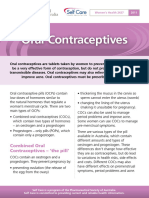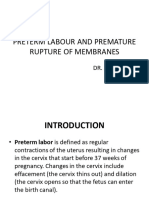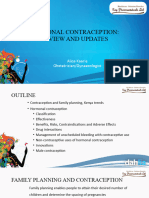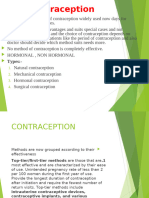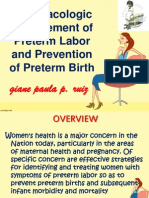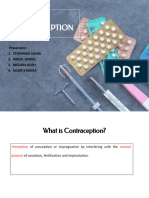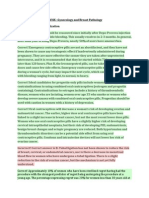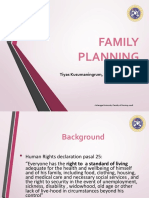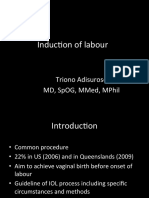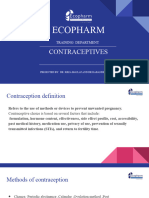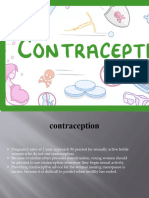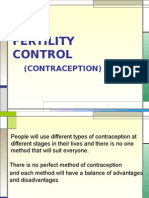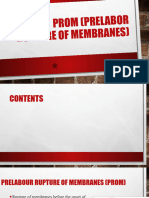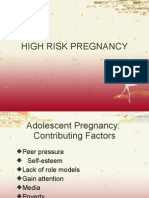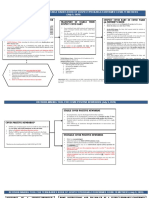CLINOHARREPORTDS
CLINOHARREPORTDS
Uploaded by
Micah Lou CalambaCopyright:
Available Formats
CLINOHARREPORTDS
CLINOHARREPORTDS
Uploaded by
Micah Lou CalambaOriginal Title
Copyright
Available Formats
Share this document
Did you find this document useful?
Is this content inappropriate?
Copyright:
Available Formats
CLINOHARREPORTDS
CLINOHARREPORTDS
Uploaded by
Micah Lou CalambaCopyright:
Available Formats
SECTION 11 WOMEN’S HEALTH The most commonly used reversible method of
contraception containing estrogen and a progestin,
45 CONTRACEPTION
and are very effective in preventing pregnancy is
• The term “contraception” is defined as the the COMBINATION ORAL
intentional prevention of pregnancy. CONTRACEPTIVE PILLS (COC)
• Contraception (birth control) prevents Oral Contraceptive Risks and Adverse Effects
pregnancy by interfering with the normal
Some women may not be candidates for a COC
process of ovulation, fertilization, and
because of the risks and adverse effects associated
implantation.
with use.
• Contraception choices have medical,
Other women may experience minor side effects
personal and public health considerations.
with COC that may be managed by changing to a
• The personal aspects include issues related formulation with a different type or dose of estrogen
to sexuality, religious, or cultural beliefs. or progestin.
• Medical conditions that affect contraceptive Benefits of Oral Contraceptives
selection or the risks associated with
Acne
pregnancy also must be considered.
• Depending on the woman, COC use may
• are therefore pharmaceuticals or devices that
cause acne to appear, disappear, or
prevent pregnancy.
significantly improve.
GOAL
• Most women will have improvement in acne
- The goal of contraception “therapy” is to with any COC used, only a few formulations
prevent unintended pregnancy without are FDA approved for this indication.
causing adverse effects and to preserve
Benign Breast Disease
fertility, when desired.
• A 50% to 75% reduction in the risk of
COMPARISON OF CONTRACEPTIVE
fibroadenomas, chronic cystic breast
METHOD EFFECTIVENESS
disease, and breast biopsies appears to exist
in COC users.
The effectiveness of any contraceptive method • The progestin component may be primarily
depends on its mechanism of action, availability responsible for this protection, progestin-
(e.g., if a prescription is required, cost), adherence, dominant COCs that contain a less
and acceptability (e.g., side effects, ease of use, estrogenic progestin such as levonorgestrel,
religious and social beliefs). are preferred.
Manipulating the normal physiologic feedback Dysmenorrhea and Premenstrual Syndrome
mechanisms of the menstrual cycle using estrogen
• Premenstrual tension has been reported to be
and progestin has proved to be an effective method
reduced 29% in COC users, and other
of contraception.
premenstrual symptoms seem to be relieved
Estrogens are hormones that are important for as well.
sexual and reproductive development, mainly in
Endometrial Cancer
women.
• Clinical data suggest that cyclic COCs
Progestin is a natural or synthetic steroid hormone,
contain sufficient progestin to prevent
such as progesterone, that maintains pregnancy and
endometrial hyperplasia and to reduce the
prevents further ovulation during pregnancy.
risk of endometrial cancer by about 50% to hospitalizations and deaths stemming from
70%. ectopic pregnancies.
• The protection is directly related to duration Other Issues with Oral Contraceptives
of use and may persist for many years after
• Breast Cancer
discontinuation.
• Depression
• A meta-analysis of 11 studies showed a
56%, 67%, and 72% reduction in • Diabetes
endometrial cancer risk after 4, 8, and 12
years of COC use, respectively. • Gallbladder Disease
Menorrhagia (Heavy Menstrual Bleeding) • Use During Pregnancy and Breastfeeding
• The total amount of menstrual flow in 46 OBSTETRIC DRUG THERAPY
established COC users is decreased by up to Prenatal Care
40%, which may caused by the progressive
thinning of the endometrium induced by use • The goal of prenatal care is to promote a
or a lack of irregular bleeding. safe and successful pregnancy and the
delivery of a healthy infant, can be achieved
• Bleeding may be decreased the most by through education and by monitoring the
COCs that have a high ratio of progestin to health of the mother and fetus.
estrogen, because endometrial thinning is
maximized. Conception begins with the fertilization of
an ovum.
Ovarian Cancer and Functional Ovarian Cysts
• Conceptional or Developmental Age
• The risk of developing functional ovarian
cysts is decreased, pre-existing cysts are – Is the time after conception.
more rapidly resolved, and surgery rates for • Gestational age or Menstrual Age
ovarian masses are reduced in women taking
COCs. – is the time from the start of the last
menstrual period (LMP) and
• This is likely owing to reducing ovulation, generally exceeds the developmental
suppressing androgen production, or age by 2 weeks.
increasing progesterone levels.
Definitions
• Parity and Gravida
Pelvic Inflammatory Disease and Ectopic
Pregnancy – Parity and Gravida are terms used to
describe a pregnant woman.
• Many clinicians prefer to prescribe COCs
with condoms for STD protection to young Parity - is the number of deliveries after 20
women with multiple sexual partners weeks’ gestation.
because PID has been found to be less
Gravida - refers to the number of
prevalent with this combination of
pregnancies a woman has had regardless of the
contraceptive methods.
outcome.
• The risk of ectopic pregnancy is greater for
Trimesters of Pregnancy
women who already have had PID, and
COC use has been shown to prevent • The average pregnancy is approximately 280
days or 40 weeks when calculated from the
first day of the LMP (Last Menstrual pregnancy are significantly less
Period). likely to have a child with neural
tube defects (NTD).
• Pregnancy is typically divided into three
trimesters, approximately 13 to 14 weeks • Calcium Requirements
each.
– Calcium is needed during pregnancy
Delivery for adequate mineralization of the
fetal skeleton and teeth, especially
• Depending on the gestational age at the time
during the third trimester when teeth
of delivery, the result can be an abortion,
are formed and skeletal growth is
preterm, term, or post-term birth.
greatest.
• Abortion (Spontaneous or Terminal)
DIABETES MELLITUS
• is a delivery before 20 weeks’
• Diabetes mellitus is the most common
gestation.
maternal medical complication during
• A term infant is a fetus delivered between 37 pregnancy.
and 42 weeks gestation.
Diabetes during pregnancy can be detected
Preterm Birth before or during pregnancy and can be separated
in two groups:
– is one occurring
between 20 and 37 (a) Pregestational Diabetes, which includes women
weeks’ gestation. who have been diagnosed before pregnancy with
either insulin dependent or insulin-independent
Post-term Birth (Postmaturity) diabetes mellitus.
– birth occurs after the (b) Gestational Diabetes Mellitus (GDM) defined as
beginning of 43 carbohydrate intolerance first detected during
weeks’ gestation. pregnancy.
– Parturition refers to INSULIN THERAPY
labor, and the
Puerperium is the 6 to • Insulin is the hypoglycemic of choice during
8 weeks after pregnancy because it does not cross the
delivery. placenta and has an established safety record
for both mother and fetus.
VITAMINS AND MINERALS
• The goal with insulin therapy is to imitate
• Iron Requirements the glucose levels of a healthy pregnant
– Iron requirements increase during woman.
pregnancy because of maternal blood ORAL HYPOGLYCEMICS
volume expansion, fetal needs,
placenta and cord needs, and blood • Oral hypoglycemics are used commonly to
loss at time of delivery. treat type 2 diabetes in nonpregnant women.
• Folate Requirements • With more than half of pregnancies being
unplanned, many discover their pregnancy
– Folic acid is essential in the synthesis status while taking these medications.
of DNA and RNA. Pregnant women
who take 0.4 to 0.8 mg of folic acid • A switch to insulin therapy is recommended
daily during the first trimester of before conception, if possible, or at the time
the pregnancy is confirmed because many
patients have inadequate control with oral
ALTERNATIVE ANTIHYPERTENSIVE
hypoglycemic agents.
DRUGS
• Control of blood glucose levels during the
• Nifedipine
preconception period and early first
trimester is of utmost importance to decrease – Nifedipine (Procardia, Adalat) has
the risk of congential malformations. been used in doses of 10 mg for
acute treatment of severe
HYPERTENSION
hypertension during pregnancy
• Hypertensive disease occurs in 5% to 10% because it can be given orally.
of all pregnancies and is a major cause of
maternal and perinatal morbidity and
mortality. 47 DISORDERS RELATED TO THE
MENSTRUAL CYCLE
• Hypertension in pregnancy is defined as a
systolic BP ≥140 mm Hg or a diastolic BP
≥90 mm Hg on two separate occasions at
least 6 hours apart. 48 THE TRANSITION THROUGH
MENOPAUSE
ANTIHYPERTENSIVE DRUG THERAPY
• The goal of antihypertensive therapy for
SECTION 12 ENDOCRINE DISORDERS
women with chronic hypertension during
pregnancy is to minimize the risks to the 49 THYROID DISORDERS
mother of an elevated BP without
compromising placental perfusion. 50 DIABETES MELLITUS
METHYLDOPA SECTION 13 EYE DISORDERS
51 EYE DISORDERS
• Methyldopa (Aldomet) is a centrally-acting
SECTION 14 NEUROLOGIC
α-agonist that decreases sympathetic
outflow to decrease BP. DISORDERS
52 HEADACHE
• It is the antihypertensive most commonly
used for chronic treatment of hypertension
in pregnancy. 53 PARKINSON’S DISEASE AND
ALTERNATIVE ANTIHYPERTENSIVE DRUGS OTHER MOVEMENT
DISORDERS
• Labetalol
– Labetalol (Trandate) is the second
any disorder associated with two or more
most commonly used drug to treat features of tremor, rigidity, bradykinesia, or
severe hypertension during postural instability.
pregnancy.
CAUSES
– It should be administered IV in
increasing doses of 20, 40, and 80 - caused by a loss of nerve cells in the
mg every 10 minutes to a cumulative part of the brain called the substantia
dose of 300 mg or until the diastolic nigra
pressure is <100 mm Hg. - Genetics
- Environmental factors CAUSES :
- medication (drug-induced
brain injury, such as trauma, stroke, brain
parkinsonism)
infection, or a brain tumor.
- other progressive brain conditions
- cerebrovascular disease PREVENTIVE MEASURES
PREVENTIVE MEASURES - Get plenty of sleep each night
- Learn stress management and
- Avoid using herbicide and pesticides
relaxation techniques.
- Eat vegetables (dark green vegetables)
- Avoid drugs and alcohol.
- Incorporate Omega 3 fatty acids to
- Take all of your medications as
your diet
prescribed by your physician
- Regular exercise
MEDICATION/ TREATMENT
55 CEREBROVASCULAR DISORDERS
1. Carbidopa levodopa - refers to a group of conditions that can lead
to a cerebrovascular event, such as a stroke.
Levodopa is combined with carbidopa
(Lodosyn), which protects levodopa from Transient ischemic attack
early conversion to dopamine outside your • Describes the clinical condition in
brain. This prevents or lessens side effects with the patient experiences a
such as nausea temporary focal neurologic deficit
2. Dopamine Antagonist such as speech, aphasia, weakness or
paralysis of a limb or blindness
Unlike levodopa, dopamine agonists don't
change into dopamine. Instead, they mimic Cerebral infarction
dopamine effects in your brain. • A permanent neurologic disorder
3. Mao B Inhibitors characterized by symptoms similar to
TIA.
They help prevent the breakdown of brain
dopamine by inhibiting the brain enzyme • Caused by the death of neurons in the
monoamine oxidase B (MAO B). This focal area of the brain
enzyme metabolizes brain dopamine. Cerebral haemorrhage
4. COMT Inhibitors • Involves escape of blood from blood
This medication mildly prolongs the effect vessels into the brain and its
of levodopa therapy by blocking an enzyme surrounding structures.
that breaks down dopamine. CAUSES
- Damage to blood vessels
54 SEIZURE DISORDERS
- Low oxygen supply
A seizure is a sudden, uncontrolled electrical - Inflammation in the arteries
disturbance in the brain
PREVENTIVE MEASURES
quitting smoke, getting regular physical SECTION 15 INFECTIOUS
exercise, eating a heart-healthy, low-fat diet, DISEASE
avoiding obesity, controlling blood pressure 56 PRINCIPLES OF INFECTIOUS
and hypertension, lowering cholesterol, and DISEASES
avoiding chronic stress or anger.
MEDICATION/ TREATMENT Approaching the problem
1. CAROTID ENDARTERECTOMY • The proper selection of antimicrobial
therapy is based on several factors:
Carotid endarterectomy (CEA) is a
• establish the presence of infection
common surgical procedure for
correcting atheromatous lesions • site of infection, signs and symptoms must
responsible for causing a TIA. be identified
• laboratory tests
2. ASPIRIN
• drug selection
Because platelets play a key role in the
formation of atheromatous clots various • dosage must be based on patient's size, age,
antiplatelet drugs, such as aspirin, site of infection.
sulfinpyrazone, dipyridamole,
ticlopidine, and clopidogrel have been A. Establishing the presence of an infection
tried to prevent ischemic strokes.
B. Establishing the severity of an infection
3. DIPYRIDAMOLE
C. Problems in the diagnosis of an infection
Two pharmacologic actions of -confabulating variables (major surgery, acute
dipyridamole prompted investigations myocardial infarction), initiation of corticosteroids
into its use in preventing TIAs and can increase WBC
ischemic stroke. Dipyridamole weakly -drug effects (dexamethasone can reduce
inhibits platelet aggregation and platelet inflammation)
phosphodiesterase and has potential
D. Establishing the site of an infection
vasodilating properties through its
inhibition of adenosine uptake in -most likely sources of infection
vascular smooth muscle. -respiratory-bronchitis (H. influenzae)
4. TICLOPIDINE -skin and soft tissue- cellulitis (E. coli)
Ticlopidine (Ticlid) is an antiplatelet E. Determining likely Pathogens
agent approved only for the prevention of -(bacteria, fungi,viruses, chlamydiae, rickettsiae,
TIA and stroke for patients with a prior mycoplasmas, spirochetes,mycobacteria)
cerebral thrombotic event. F. Microbiologic tests and susceptibility of
organisms
- Culture and susceptibility
1. Disk diffusion (Kirby-Bauer) 4. Dirty- penetrating trauma
-uses agar plate Suggested Prophylactic Antimicrobial regimens
- if antimicrobial is active against pathogen, a zone 1. Clean
of inhibition is observed
cardiac-S. aureus-cefazolin-1g IV
2. Broth dilution
thoracic-S. aureus-cefazolin-1g IV
-involves placing bactrial inoculum into test tubes
2. Clean-contaminated
-cloudy- bacterial growth occured
head and neck- S. aureus-cefazolin- 2g IV
G. Antimicrobial dosing
colorectal- gram-negative enterics- oral
-site of infection requires differing dosage neomycin-erythromycin- 1g each at 1pm,
requirements 2pm and 11pm day before the surgery
-anatomic and physiological barriers (penetration appendectomy(uncomplicated)-B. fragilis-
into CNS requires high doses) cefoxitin-1-2g IV
-route of elimination (eliminated via renal or
norenally)
Principles of surgical antimicrobial
-patient age
1. Decision to use antimicrobial prophylaxis
eg. aminoglycosides
- selected prophylactic agent should be
57 ANTIMICROBIAL PROPHYLAXIS directed against infecting organisms but not
FOR SURGICAL PROCEDURES to eradicate every potential pathogen
• Prophylactic antibiotics are used in surgical 2. Timing of antimicrobial administration
procedures and account substantial antibiotic - for maximal efficacy, an antibiotic should
use in many hospitals be present in therapeutic concentrations at
• reduce the prevalence of postoperative the incision site as early as possible during
wound infection at or around the surgical decisive period and until wound is closed
site 3. Route of administration
• antimicrobial prophylaxis should be given - oral admin is not recommended because of
for surgical procedures: a) with high rate of unreliable or poor absorption
infection b) involving implantation c)
infections that would have catastrophic - oral regimen against fecal flora is 1g each
consequences of nonabsorbable neomycin sulfate and
erythromycin base
Wound Classifaction
-parenteral regimens are effective in
1. clean- no acute inflammation or entry into colorectal procedures
GI, respiratory
4. Duration of adminstration
2. clean-contaminated- elective, controlled
opening of GI, respiratory, biliary - the shortest effective prophylactic course
of antibiotics should be used
3. contaminated- penetrating trauma, major
technique break or major spillage from the - postoperative doses after wound closure
GI tract are usually not required and may increase
resistance
5. Selection of an Antimicrobial Agent • extremely serious that requires immediate
care
- cefazolin is considerably less expensive
than broader-spectrum agents and is • can lead to permanent damage or brain
currently recommeded by the American disability
College of Obstetricians and Gynecologists
• spreads by: coughing or sneezing
58 CENTRAL NERVOUS • treatment available: antibiotics as per
SYSTEM INFECTIONS causative agent
Meningitis • causative agents: S. pneumonia, N.
meninges- layers of tissue that separates the meningitis, H. influenza
skull and the brain Tubercular meningitis
meningitis- acute inflammation of the • caused by M. tuberculosis
meninges caused by virus or bacteria
• infection begins in the lungs
Route of entry in the CNS
• progresses very slow and symptoms are
• skull or back bone fractures (trauma) vague
• medical procedures Viral meningitis
• along peripheral nerves • aka aseptic meningitis
• blood or lymphatic system • more common than bacterial meningitis and
Etiology less serious
The causes can be classified into: • less likely to have permanent damage
-bacterial infections • treatment: no specific treatment avalable
-viral infections • patients recover on their own
-fungal infections • causative agents: enterovirus, adenovirus,
arbovirus
Fungal meningitis
Pathophysiology
• less common than the two infections
• bacteria enters blood stream/trauma
• rare in healthy people but it is more likely in
• enters mucosal cavity persons who have impaired immune system
• breakdown of normal barries • risk factors: systemic infections, tobacco
use, over crowding
• crosses blood brain barrier
Clinical manifestations
• proliferates in the CSF
• inflammation of the meninges • Infants: fever, vomiting, high pitch moaning
cry, neck retraction, pale and blotchy
• increase in ICP complexion
Bacterial meningitis • Adults: stiff neck, headache, fever,
vomitting, joint pain
• aka septic meningitis
Medical management
• Bacterial meningitis • caused by: S. viridans or enterococcus
- third generation cefalosporins such as epidemiology and etiology
cefotaxime or cetriaxone
• mean male-to-female ratio is 1.7:1
-vancomycin is added in case of resistance
Risk factors
-dexamethasone
• presence of prosthetic heart valve (highest
-fluid therapy risk)
-phenytoin for seizure management • previous endocarditis
• Tubucular meningitis: • hypertrophic cardiomyopathy
-are started with Rifampicin, Pyrazinamide and • presence of IVDA
Streptomycin
• increased longevity leads to more
-Second line drugs: Aminoglycosides, degenerative valvular disease, placement of
Fluoroquinolones prosthetic valves and increased exposure to
nosocomial bacteremia
-conventional therapy is given for 6-9 months
PROSTHETIC HEART VALVES
- in children BCG vaccine offer protective effect
Onset
59 ENDOCARDITIS within 2 months of surgery early and usually
hospital acquires
INFECTIVE ENDOCARDITIS
12 months post surgery late onset and usually
• Inflammation of the endocardium, the community acquired
membrane lining the chambers of the heart
and covering the cusps of the heart valves NOSOCOMIAL INFECTIVE
ENDOCARDITIS
CHARACTERISTICS
• half of the cases is linked to intravascular
• vegetation devices
- pathological lesion composed of platelets, • other sources: surgical wound infection
fibrin, microorganisms and inflammatory cells
ETIOLOGICAL AGENTS
• Acute/Subacute-chronic
1. Streptococci
• by organism
- S. viridans/ alpha-hemolytic streptococci
native valve or prosthetic valve like S. mitis, S. sanguis, S. oralis
Acute Endocarditis -S. bovis
• toxic progression 2. Enterococci
• progressive valve destruction- days to weeks -E. faecalis and E. faecium
• Commonly caused by S. aureus -associated with GIT procedures
Sub-acute 3. Staphylococci
• mild toxicity -most common cause of INFECTIVE
• weeks to months ENDOCARDITIS
-S. aureus: Native valves and acute TTE
endocarditis
• TRANS- THORACIC
-Coagulase-negative staphylococci: ECHOCARDIOGRAPHY
Prosthetic valve endocarditis
-obesity, COPD, and chest wall deformities
PATHOGENESIS
TOE
• Altered valve surface
• Transesophageal echo
• deposition of platelets and fibrin
-evaluate myocardial invasion
• bacteremia- attaches to platelet-fibrin
-more cost effective in those with S. aureus
deposits
COMPLICATIONS
-covered by more fibrin
• Congestive heart failure-valvular damage,
-protedted from neutrophils
higher mortality
-division of bacteria
• Systemic emboli
-mature vegetation
GOALS OF THERAPY
SITE OF INFECTION
• Eradicate infxn
• Aortic valve more common than mitral
• treat sequel of destructive intra-cardiac and
• Aortic extra-cardiac lesions
- dynfxn of the valve THERAPY
MItral • Antimicrobial therapt
- dysfxn by rupture of chordae tendineae • Surgery
CLINICAL MANIFESTATIONS ANTIBIOTICS
• fever • Penicillin G- 12-18 million units/ day IV in
6 doses
• anorexia. weight loss, night sweats
• amoxicillin 4-6 doses per day
• heart murmur
• ceftriaxone with gentamycin/ netilmicin
• petechiae on the skin
in beta lactam allergic px
• oral mucosa
• Janeway lesions
-vancomycin
• Splinter hemorrhages INDICATIONS FOR SURGERY
• Osler nodes • HF
Investigations • uncontrolled infection
• blood culture • prevention of embolism
• TTE/TOE
• ESR/CRP
Pathogenesis
60 RESPIRATORY TRACT
Latent infection vs Active disease
INFECTIONS
Latent infection occurs when the tubercle
61 TUBERCULOSIS bacilli are inhaled into the body. After
inhalation, the droplet nuclei containing M.
tuberculosis settle into the bronchioles and
History
alveoli of the lungs.
Tuberculosis is an ancient disease, and
Persons with latent TB infection are not
evidence of TB dates back as far as
infectious and cannot spread TB infection to
prehistoric times with evidence being found
others.
in pre-Columbian and early Egyptian
remains. However, TB did not become a A person with Latent TB infection
problem until the 17th and 18th centuries Usually has a skin test or blood test
when crowded living conditions of the result indicating TB infection
industrial revolution contributed to its
epidemic numbers in Europe and the United Has a normal chest x-ray and a
States. negative sputum test
Early physicians referred to Tb as Phthisis, Has TB bacteria in his/her body that
derived from the Greek term for wasting, are alive, but inactive
because its clinical presentation consisted of Does not feel sick
weight loss, cough, fevers, and hemoptysis.
Cannot spread TB bacteria to others
1882- Robert Koch isolated and cultured
Mycobacterium tuberculosis and Needs treatment for latent TB
demonstrated its infectious nature. infection to prevent TB disease;
however, if exposed and infected by a
Etiology person with multidrug-resistant TB or
Tuberculosis is caused by M. tuberculosis, extensively drug-resistant TB,
an aerobic, non-spore-forming bacillus that preventive treatment may not be an
resists decolorization by acid alcohol after option.
staining with basic fuchsin. For this, season Active disease
the organism is often referred to as an acid-
fast bacillus (AFB). It is also different from In some people, TB bacteria
other organisms in that it replicates slowly overcome the defenses of the immune
once every 24 hours instead of every 20 to system and begin to multiply,
40 minutes as do some other organisms. M. resulting in the progression from
tuberculosis thrives in environments where latent TB infection to TB disease.
the oxygen tension is relatively high, such as Some people develop TB disease soon
the apices of the lung, the renal parenchyma, after infection, while others develop
and the growing ends of bones.
GENERAL SYMPTOMS OF TB 80% effective in preventing TB for
DISEASE 15 years
Unexplained weight loss More effective against complex forms
of TB in children
Loss of appetite
Of limited effectiveness in people
Night sweats
over the age of 35
Fever
Early diagnosis
Fatigue
early diagnosis and treatment is the
Chills most effective way to prevent the spread
TB disease later when their immune of tuberculosis.
system becomes weak. Managing you environment
THE SYMPTOMS OF TB OF THE As TB is an airborne infection, TB
LUNGS bacteria are released into the air when
Coughing for 3 weeks or longer someone with infectious TB coughs or
sneezes. The risk of infection can be
Hemoptysis (coughing up blood) reduced by using a few simple
Chest pain precautions:
DIAGNOSTICS: Good ventilation
Mantoux test (purified protein Natural light
derivative test) measure the Good hygiene
induration. It reveals only the
exposure of TB. TREATMENT
Direct sputum smear microscopy- Drugs use in Tuberculosis
primary diagnostic tool First line drugs
Chest X-ray severity of lung lesions Rifampin
brought about by the bacteria.
Isoniazid
PREVENTIVE MEASURES
Pyrazinamide
BCG vaccination
Ethambutol
Bacille Calmette-Guerin is a live
Streptomycin
vaccine against tuberculosis. The vaccine
is prepared from a strain of the weekened Alternative drug
bovine tuberculosis bacillus,
Amikacin
Mycobacterium bovis.
Ciprofloxacin
BCG is:
Ethionamide MOA: inhibition of the synthesis of
myolic acid, essential components of
P-aminosalycylate
mycobacterium cell walls.
Rifampin
Resistance MOA:
MOA: inhibits DNA-dependent and RNA
High level resitance is associated with
polymerase (encoded by rpo gene)
deletion in the KatG gene that codes
Resistance MOA: resistance via changes in for a catalase-peroxidase involved in
drug sensitivity of the polymerase after the bio activation of INH.
emerges rapidly if the drug is used alone.
Low level resistance occurs via
deletion in the inhA gene that encodes
Toxicity: the target enzyme an acyl carrier
protein reductase.
Commonly cause light chain
proteinuria and may impair antibody Toxicity:
response Neurotoxic effects are common and
Strongly induces liver drug include peripheral neuritis,
metabolizing enzymes and enhances restlessness, muscle twitching and
the elimination rate of many drugs insomnia. These effects can be
including: alleviated by administration of
Pyridoxine ( vitamin B6 ) 25-50 mg/d,
Anticonvulsants orally
Contraceptive steroids Hepatotoxic
Cyclosporine Inhibit the hepatic metabolism of
Ketoconazole drugs
Methadone Carbamazepine
Terbinafine Phenytoin
Warfarin warfarin
Rash Pyrazinamide
Nephritis MOA: bacteriostatic action appears to
require metabolic conversion via
Thrombocytopenia pyrazinamide's (encoded by the pncA
Flu like syndrome with intermittent gene) present in M. tuberculosis.
dosing Resistance MOA: resistance occurs
Isoniazid via mutations in the gene that encodes
enzymes involved in the bio
activation of pyrazinamide and by
increased expression of drug efflux Possible retinal damage (from
systems. prolonged use as high doses)
toxicity Other adverse effects includes
Approximately 40% of patients Headache
develop nongouty polyarthralgia
Confusion
Hyperuricemia occurs commonly but
Hyperurecemia
is usually asymptomatic
Peripheral neuritis
Other adverse effects are
ALTERNATIVE DRUG
Myalgia
Amikacin is indicated for the
GI irritation
treatment of tuberculosis suspected to
Maculopopular rash be cause by streptomycin resistant or
multidrug resistance.
Hepatic dysfunction
Ciprofloxacin and ofloxacin are often
Porphyria
active against strains of m.
Photosensitivity reactions tuberculosis resistance to first line
Should be avoided in pregnancy agents.
Ethambutol Ethionamide is a congener of INH,
but cross resistance does not occur.
MOA: inhibits arabinosyltranferases
(encoded by the embCAB operion) Standard regimens
involved in the synthesis of Initial 3 drug regimen (R, I, P)
arabinogalactan, a component of
If the organism are fully susceptible
mycobacterial cell walls.
pyrazinamide can be discontinued
Resistance MOA: resistance occurs after 2 months with a 2 drug regimen.
rapidly via mutations in the emb gene
Alternative regimens
if the drug is used alone.
INH + Rifampin for 9 months
Toxicity:
INH + ethambutol for 18 months
The most common adverse effectsd
intermittent (2-3 x weekly) high-dose
are dose dependent visual
disturbances 4drug regimen are also effective
Decreased visual acuity
Red-0green color blindness
Optic neuritis
• Shigella species
62 INFECTIOUS DIARRHEA
• Salmonella species
• Clostridium difficile
Infectious diarrhea is caused by th ingestion
of food or water contaminated with • Shiga toxin-producing E.coli (STEC)
pathogenic microorganism or their toxins. • Entamoeba histolytica
Diarrhea is often defined as three or more
episodes of loose stool or any loose with
63 INTRA-ABDOMINAL INFECTIONS
blood during a 24-hour period. PERITONITIS
Classification of infectious diarrhea
- Inflammation of the peritoneum, the
Noninflammatory diarrheas are generally a tissue that lines that lines the inner
less severe illness in which patients present wall of the abdomen and covers and
with nonbloody, watery stools; patients are supports most of your abdominal
afebrile and without significant abdominal organs. Peritonitis is usually caused
pain. by infection from bacteria and fungi.
- If left untreated, peritonitis can
Noninflammatory diarrheas are typically
rapidly spread into the blood (sepsis)
caused by:
and the other organs.
• Rotaviruses
Symptoms of peritonitis
• Noroviruses
• Poor appetite
• Staphylococcus aureus
• Nausea
• Bacillus cereus
• Dull abdominal ache
• Clostridium perfringens
• Abdominal tenderness or distention
• Cryptosporidium parvum
• Chills
• Giardia lamblia
• Fever
Inflammatory diarrheas are generally a
• Fluid in the abdomen
more severe illness in which patients
present with bloody diarrhea, severe • Difficulty in passing gas or having a
abdominal pain, and fever, and bowel movement
examination of stool specimens reveals
• Vomiting
the presence of large numbers of fecal
leukocytes. Two type of peritonitis:
Inflammatory diarrheas are caused by • Primary spontaneous peritonitis, an
invasive pathogens including, infection that develops in the
peritoneum.
• Campylobacter jejuni
• Secondary peritonitis, which usually
develops when an injury or infection
in the abdominal cavity allows
infectious organisms into the
peritoneum.
Most common risk factors for primary
spontaneous peritonitis include:
1. Liver disease with cirrhosis such
disease often causes a buildup of
abdominal fluid (ascites) that can
become infected.
2. Kidney failure getting peritoneal
dialysis.
Common cause of secondary peritonitis
include:
1. a ruptured appendix, diverticulum or
stomach ulcer
2. Digestive disease such as crohn’s
disease and diverticulitis.
3. Pancreatitis
4. Pelvic inflammatory disease
5. Perforations of the stomach, intestine,
gallbladder or appendix.
Diagnostics test:
1. Blood and urine tests
2. Imaging studies such as x-rays and
computerized scans.
3. Exploratory surgery
-
64 URINARY TRACT
INFECTIONS
Is an infection of the body’s urinary
system.
- It is an infection caused by microbes.
urinary tract is made up of:
o Kidneys
o Ureters
o Bladder
o Urethra
o Most UTIs only involve the urethra
and bladder, in the lower tract.
o UTIs can involve the ureters and
kidneys, in the upper tract. Although SYMPTOMS
upper tract UTIs are more rare than Urinary tract infection don’t always
lower tract UTIs, they’re also usually cause signs and symptoms, but when
more severe. they do they may include:
‐ A strong, persistent urge to urinate
CAUSES:
‐ A burning sensation when urination
- Typically occur when bacteria enter ‐ Passing frequent, small amounts of
the urinary tract through the urethra urine
and begin to multiply in the bladder. ‐ Urine that appears red, bright pink or
- When that happens, the bacteria take cola-colored – a sign of blood in the
hold and grow into a full-blown urine
infection in the urinary tract. ‐ Strong-smelling urine
Most common UTIs occur mainly in the ‐ Pelvic pain, in women – especially in
women and affect the bladder and urethra the center of the pelvis and around the
area of the pubic bone
Infection of the bladder (cystitis)
PREVENTIVE MEASURES
This type of UTI is usually caused by
Escherichia coli.
However, sometimes other bacteria
are responsible.
Infection of the urethra (urethritis)
This type of UTI can occur when GI
bacteria spread from the anus to the urethra.
Also, because the female urethra is
close to the vagina and sexually transmitted DIAGNOSIS
infections can cause urethritis. o Analyze a urine sample
Herpes, gonorrhea, chlamydia and • urinalysis
mycoplasma
o Growing urinary tract bacteria in the
lab
• Urine culture
o Creating images of your urinary tract
65 SEXUALLY TRANSMITTED
• CT scan
DISEASES
• MRI also called sexually transmitted
o Using scope to see inside your bladder infections, or STIs.
- are infections spread from person to
• Cystoscopy person during sex
TREATMENT - Sometimes these infections can be
transmitted nonsexually
Simple infection - From mother to infant during
Drugs that are commonly recommended: pregnancy or childbirth
- Blood transfusion or shared needle
o Trimethorprim/sulfamethoxazole - Can be through vaginal, oral, or anal
o Fosfomycin (monurol) or close intimate contact
o Nitrofurantoin (macrodantin, Causes:
macrobid) × Bacteria
o Cephalexin × gonorrhea
o Ceftriaxone × Syphilis
Severe infection × chlamydia
May need treatment with IV antibiotics × Parasites
in the hospital
× trichimoniasis
Frequent infections
× Viruses
o Low-doe antibiotics, initially for six
month but sometimes longer × Human papillomavirus
o Self-diagnosis and treatment, if you × Genital herpes
stay in touch with your doctor × Human immunodeficiency
o A single doe of antibiotic after sexual virus
intercourse if your infections are Types of sexually transmitted disease:
related to sexual activity
HIV (human immunodeficiency virus)
o Vaginal estrogen therapy if you’re
posstmenopausal - is the virus that causes AIDS.
- HIV attacks the immune system by
destroying CD4 positive (CD4+) T
cells
- The destruction of these cells leaves
people infected with HIV vulnerable
to other infections, diseases and other Type 1 (HSV-1) - cold sores
complications
Type 2 (HSV-2) – genital
- Viral STD herpes
Common symptoms:
× Flu-like illness - It causes herpetic sores which are
painful blisters
× Swollen lymph nodes
Common symptoms:
× Skin rash
× Fever & flu-like symptoms
Many people do not notice symptoms
× Muscle aches
Treatments: (ANTIRETROVIRUS
TREATMENT/ ART) × Painful urination
× TDF (tenofivir) × Tingling, burning or itching sensation
in the area where the blisters are
× 3TC (lamivudine) or FTC
(emitricitabine) Treatments:
× EFV (efavirenz) There is no cure for Herpes.
Chlamydia However, there are some medication to
treat or prevent symptoms:
Causative agent: Chlamydia trachomatis
- Acyclovir (Zovirax)
- It can cause cervicitis in women and
urethritis and proctitis in both men - Famciclovir (Famvir)
and women.
- Valacyclovir (Valtrex)
- Bacterial STD
GONORRHEA
Common symptoms:
Causative agent: Neisseria gonorrhoeae
× Discharge from the vagina, penis or bacterium
anus
- infects the mucous membranes of the
× Burning when urinating reproductive tract, including:
Often there is no symptoms Cervix
Treatments: Uterus
Azithromycin (single or large dose) Fallopian tubes (women)
Doxycycline (twice per day for 1 week) Urethra (women and men)
GENITAL HERPES - can also infect the mucous
membranes of the mouth, throat, eyes,
Causative agent: Herpes simplex viruses
and rectum
Common symptoms: Urine sample
× Discharge from the vagina, penis or Fluid sample
anus
× Burning when urinating
Women often do not notice symptoms
Men may have symptoms in the penis
Treatments:
There is no cure for Herpes.
However, there are some medication to treat 66 OSTEOMYELITIS AND SEPTIC
or prevent symptoms: ARTHRITIS
- Acyclovir (Zovirax) 67 TRAUMATIC SKIN AND SOFT
TISSUE INFECTIONS
- Famciclovir (Famvir)
- Valacyclovir (Valtrex) 68 PREVENTION AND
TREATMENT OF INFECTIONS IN
NEUTROPENIC CANCER
PREVENTIVE MEASURES PATIENTS
× Abstain
69 PHARMACOTHERAPY OF
× Stay with one uninfected partner HUMAN
× Avoid vaginal or anal intercourse with IMMUNODEFICIENCY VIRUS
new partners until you have both INFECTION
been tested for STIs
70 OPPORTUNISTIC INFECTIONS
× Practice safer sex every time you have IN HIV-INFECTED
sex PATIENTS
× Get vaccinated early, before sexual 71 FUNGAL INFECTIONS
exposure
72 VIRAL INFECTIONS
× Don’t drink alcohol excessively or use
drugs 73 VIRAL HEPATITIS
× Consider male circumcision 74 PARASITIC INFECTIONS
× Consider truvada 75 TICK-BORNE DISEASES
DIAGNOSIS SECTION 16 PSYCHIATRIC
DISORDERS
Blood sample
77 SLEEP DISORDERS
SS : Consistent failure to get enough sleep 2. Prenatal Damage
or restful sleep * Malnutrition
Consistently feeling tired upon waking &/or * Viruses
waking with a headache
3. Environment
Chronic fatigue, tiredness, sleepiness during
the day * Family Stress
Struggling to stay awake while driving or * Poor Social Interactions
doing something passive, e.g. watching TV * Infections or Viruses at an early age
Difficulty concentrating at work or school * Trauma at an early age
Slowed or unusually delayed response to 4. Neurotransmitters (Biological)
stimuli or events
* too much dopamine, low levels of
Difficulty remembering things or controlling serotonin and glutamate
emotions
5. Brain Abnormalities (Biological)
Frequent urge to nap during the day
* reduced number of neurons
Snoring or ceasing to breathe during sleep
* enlarged ventricles
78 SCHIZOPHRENIA * thalamus abnormalities
₋ debilitating and emotionally Characteristic Symptoms
devastating illness with long-term At least two of the following, each present
impact on patients’ lives. for a significant portion of time during a 1-
month period :
₋ most severe expression of 1. Delusions
psychopathology, encompassing 2. Hallucinations
significant disruptions of thinking, 3. Disorganized speech
perception, emotion, and behavior. 4. Grossly disorganized or catatonic
₋ usually a lifelong psychiatric behavior
disability. 5. Negative symptoms
affects men and women with equal Note: Only one “A symptom” is required if
frequency, there are differences in the delusions are bizarre or
age of onset and course of illness. hallucinations consist of a voice keeping up
a running commentary
during late adolescence or early on the person’s behavior or thought, two or
adulthood. more conversations with
CAUSES each other.
1. Genetics – “runs in the family” TYPES
1. Disorganized Classification of Mood Disorders
* lack of emotion
A. Depressive Disorders
* disorganized speech 1. Major Depressive Disorder, Single
* silly/childlike behavior Episode
2. Major Depressive Disorder, Recurrent
* makes no sense when talking 3. Dysthymic Disorder
2. Catatonic 4. Depressive Disorder Not Otherwise
Specified
* waxy flexibility
Individuals must possess at least five
* reduced movement symptoms, one of which is either
* rigid posture depressed mood. The other seven
symptoms are as follows:
* sometime too much movement
1. Change in appetite
3. Paranoid 2. Change in sleep
* strong delusions 3. Low energy
4. Poor concentration (or difficulty making
* strong hallucinations decisions)
TREATMENT 5. Feelings of worthlessness or inappropriate
guilt
6. Psychomotor agitation or retardation
Schizophrenia is a chronic disease for which
7. Recurrent thoughts of suicide
there is no
cure. Selected Medications That May Induce
Depression
Pharmacotherapy can reduce symptoms to
improve social and cognitive functions;
however, patients have multiple relapses and Cardiovascular Agents
experience residual symptoms throughout β-blockers
their lives. Clonidine
Methyldopa
Treatment can decrease acute symptoms,
Reserpine
decrease the frequency and severity of
Central Nervous System
psychotic episodes, and optimize
Agents
psychosocial functioning between episodes.
Barbiturates
Benzodiazepines
Chloral hydrate
Ecstasy (MDMA)
79 MOOD DISORDERS I: MAJOR Ethanol
DEPRESSIVE
Hormonal Agents
DISORDERS
Anabolic steroids
Corticosteroids Malignancies (various)
Gonadotropin-releasing hormone Migraine headaches
Progestins Rheumatoid arthritis
Tamoxifen Systemic lupus erythematosus
Others
NON DRUG THERAPIES
Efavirenz
Interferon Most experts now advocate a three-pronged
Isotretinoin approach to relieving and preventing
depressive symptoms, involving
Mefloquine
Levetiracetam (a) psychotherapy
cognitive – behavioural therapy
Selected Medical Conditions That May Interpersonal therapy
Mimic Depression Psychoanalytic
Central Nervous System Psychodynamic therapy
Alzheimer disease
Cerebrovascular accident
Epilepsy (b) somatic interventions
Multiple sclerosis
Parkinson disease ECT ( Electroconvulsive therapy )
Cardiovascular - Safe, rapid acting highly effective
Cerebral arteriosclerosis therapeutic intervention that continues to
Congestive heart failure suffer, from a poor public shaming
Myocardial infarction -done under general anesthesia in which
small electric currents are passed through
Endocrine the brain
Addison disease TMS (Trans magnetic stimulation)
Diabetes mellitus (types I and II) - non-invasive procedure involving the
Hypothyroidism application of
Women’s Health an electrical stimulus across the scalp, which
Premenstrual dysphoric disorder ultimately generates an electrical field in the
Antepartum/postpartum cerebral cortex
Perimenopause
(c) lifestyle adjustments
Other
Chronic fatigue syndrome - Reverse unhealthy or destructive lifestyle
Chronic pain syndrome(s) habits
Fibromyalgia
Irritable bowel syndrome - Alcohol, recreational drug use, and
excessive caffeine consumption should be HYPERACTIVITY/ IMPULSIVITY
minimized in patients suffering from FACTOR
depression or anxiety disorders.
• HYPERACTIVITY
- Sleep habits should be evaluated and
1. fidgets with hands/ feet or
improved to ensure optimal rest.
squirms in chair
- Dietary factors should be modified to
2. cannot remain seated in the
promote diverse, balanced, and
classroom
nutritional eating habits
3. uncontrollable/ inappropriate
- Increased physical activity and sustained
restlessness
cardiovascular exertion can impart a variety
of health benefits. 4. difficulty in engaging in play or
leisure activities quietly
80 MOOD DISORDERS II: BIPOLAR 5. often on the go and appearing
DISORDERS driven by a motor
81 ATTENTION DEFICIT 6. excesssive talking
HYPERACTIVITY DISORDER IN
CHILDREN, ADOLESCENTS, AND • IMPULSIVITY
ADULTS 7. blurts out answer prior to completion
INATTENTION FACTOR of question
1. careless mistakes or inattention to 8. difficulty waiting in turn
detail 9. interrupts or intrudes on others
2. reduce attention span • ADHD is classified into 3 subtypes:
3. poor listener hyperactive-impulsive, innattentive or
combined
4. cannot follow instructions and does
not complete tasks • approx 2.5 times more frequent
among males than females
5. difficulty organizing tasks and
activities • high rate on conduct disorder,
oppositinal defiant disorder,
6. avoid and/or dislikes chores or depression, major affective disorder
homework and anxiety disorders including OCD
7. loses things needed for tasks and and Tourette syndrome.
activities • Diagnosis:
8. easily distracted by extraneous stimuli
• exclude: head injuries, absence
9. forgetful in daily activities seizures, cerebral infection,
substance abuse,
hyperthyroidism, anxiety by a desire (but not a
disorders and mood disorders. compulsion) to continue using
the drug, no tendency to
• physical examination,
increase the dose, and an
neurological examination,
absence of physical addiction
social, family, school and
despite some degree of
medical history
physiological dependence.
PHARMACOTHERAPY
2 Groups for Substance-Related Disorders
• CNS stimulant or psychostimulant
1. Substance use disorders
medications are the DOC
- distinguishing between substance
• tricyclic antidepressants (TCAs)
dependence and substance abuse
• atomexetine
2. Substance-induced disorders
• bupropion
- intoxication, withdrawal
• clonidine
URINE SCREENING AND ITS PITFALLS
• norepinephrine and/or dopamine
• exercise and hydration
agonists
• enhancing secretion
82 EATING DISORDERS • drinking vinegar or cranberry juice
SECTION 17 SUBSTANCE ABUSE • taking vitamin C
83 DRUG ABUSE • taking saunas
• Physical addiction or dependence • buying clean urine from a drug-free
individual
• repeated administration of a
drug which causes an altered • adding bleach, isopropanol or salt to
physiologic state urine sample
(neuroadaptations)
• dehydration
• Physiological addiction or
• adding water to specimen
Psychological dependence
I. OPIOIDS
• maladaptive pattern of
substance use leading to a. Heroin
clinically significant b. Rx drugs
impairment or disease.
II. Sedative-Hypnotics
• Habituation
a. Ethanol
• a state of either chronic or
periodic drug use characterized b. Benzodiazepines
c. Carisoprodol return to complete physiologic
equilibrium may require
d. GHB
months or longer; seldom life-
III. CNS stimulants threatening
a. Cocaine • Iatrogenic dependence: after 2-
b. Amphetamines 10 days
IV. Dissociative Drugs • Overdose Treatment: airway
management, cardiorespiratory
a. Phencyclidine support and opioid reversal
b. Ketamine with naloxone (IV, IM or SC)
c. Dextromethorphan • Treatment of Opioid
Dependence: detoxification
V. Hallucinogens programs, methadone
a. LSD (treatment of choice)
b. MDMA SEDATIVE-HYPNOTICS
VI. Marijuana Ethanol
VII. Inhalants • most widely abused substance
OPIOIDS Benzodiazepines
HEROIN • prototypical sedative-hypnotic
drug of abuse
• Addiction: noticeably opioid
physical dependence GHB (Gamma-hydroxybutyric acid)
• Withdrawal: (after 6-12 hrs) • a putative neurotransmitter
anxiety, hyperactivity, abused for its euphoric and
restlessness and insomnia; sedative-hypnotic effect
(after 48-72 hrs) anorexia, Carisoprodol
nausea, vomiting abdominal
cramps and diarrhea • a nonscheduled skeletal muscle
relaxant, has an active
• During withdrawal: heart rate metabolite meproamate with
and BP may elevate, marked known abuse potential.
weight loss, dehydration,
cardiovascular collapse Txn of withdrawal:
• The more dramatic symptoms • decreasing doses of the drug of
of heroin withdrawal subside dependence
after 7-14 days of abstinence • substituting of phenobarbital
without treatment; however, a for the drug of dependence
• substituting of a long acting dilate and hypertrophic
benzodiazepine for the drug of cardiomyopathy, myocarditis, aortic
dependence dissection and acceleration of
artherosclerosis
Phenobarbital method
• Withdrawal syndrome: “crash”,
• the one most generally
depression, fatigue, craving,
applicable; widely used in drug
hypersomnolence and anxiety; can be
treatment programs because it
resolve within 1-2 weeks
is the best choice used for
patients who have lost control • Txn of addiction: dopamine agonist,
of their benzopdiazipine use or antidepressants, carbamazepine,
who are polydrug users methylphenidate (maintenance
treatment), cocaine vaccine (UI)
• involves calculating a
phenobarbital replacement dose AMPHETAMINES
for the total daily dose of the
• Caffeine
sedative-hypnotic being used.
• consumed worldwide in a
CENTRAL NERVOUS SYSTEM
usually socially acceptable
STIMULANTS
manner in the form of coffee
Cocaine and cola soft drinks
• a naturally occuring alkaloid • Methamphetamine
derived from the Erythroxylon
• produces CNS stimulation by
coca plant
enhancing the effects of
• second to marijuana as the most noepinephrine, serotonin ad
frequently used drug of abuse dopamine
• a CNS stimulant and has • accomplished by both blocking
vasoconstrictive and local reuptake and stimulating
anesthetic properties release of neurotransmitters
• stimulant effect are caused by • half-life is 6-15 hours
blockade of reuptake of
• tolerance develops very rapidly
dopamine, norepinephrine, and
after continued use
serotonin
• A/E: chronic users characteristically
• associated with compulsive use
develop complex paranoid delusional
• snorting (2 min), smoking (6-8 systems with hallucinations during
sec) with 30 min half-life extended periods of intoxication that
may involve several sleepless days
• A/E: hypertension, arrythmias,
and nights of continuous
myocardial ischemia and infarction,
methamphetamine administration.
• Txn of withdrawal: no effective profound visual hallucnosis,
pharmacologic treatments have been and the sensation of disordered
proved effected for meth dependence; integration of sensory input
most effective is cognitive-behavioral
• A/E: mental state of acute
therapy
anxiety and fear aka “bad trip”
DISSOCIATIVE DRUGS:
• therapy: “reality therapy”,
PHENCYCLIDINE, KETAMINE AND
“talking down”
DEXTROMETHORPHAN
• long term effect: Hallucinogen
Ketamine
persisting perceptual disorder
• commonly used as “club drug” (HPPD)
Dextromethorphan MDMA
• antitussive agent; a d-isomer of • produces a very manageable
the codeine analog of and comfortable entactogenic
levorphanol effect
• when ingested in large doses, it • the experience can be recalled
produces similar effect to in detail, and the insights
ketamine or PCP gained during the session can
be incorporated into normal life
• 300-1800 mg, 3-6 hours “high”
• onset of action: 30-60 min,
PCP
booster shot after 2 hours
• typical dissociative drug and
• duration of action: 4-6 hours;
review of its effects largely
half life of 8 hours
applies to ketamine and
dextromethorphan • warning: hyperthermia which
led to rhabdomyolysis and
• amnesia can occur following
acute renal and hepatic failure,
intoxication
disseminated intravascular
HALLUCINOGENS coagulation (DIC) and death
• LSD • txn: benzodiazepines, cooling
• a drug that could facilitate measures and IV fluids
psychotherapy MARIJUANA
• one of the most potent • most widely used illicit substance
hallucinogens known (25-250
• THC is the main psychoactive
mcg)
ingredient
• mild to moderate
• therapeutic potential:
sympathomimetic effects,
• relief of N/V, appetite 87 DRUG-INDUCED BLOOD
stimulation, treatment of pain, DISORDERS
epilepsy, glaucoma, migraine,
SECTION 19 NEOPLASTIC
anxiety, depression and
DISORDERS
movement disorders and
88 NEOPLASTIC DISORDERS AND
providing neuroprotection after
THEIR TREATMENT GENERAL
brain injury or cerebral
PRINCIPLES
iscehmia
89 ADVERSE EFFECTS OF
pharmacological effects:
CHEMOTHERAPY AND TARGETED
• sedation, mental relaxation, AGENTS
euphoria and mild
90 HEMATOLOGIC MALIGNANCIES
halluconogenic effects
91 SOLID TUMORS
A/E:
92 HEMATOPOIETIC STEM CELL
• anxiety, paranoia, TRANSPLANTATION
depersonalization,
SECTION 20 PEDIATRICS
disorientation and confusion
93 PEDIATRIC CONSIDERATIONS
Treatment:
94 NEONATAL THERAPY
• “talk down”, oral
benzodiazepine therapy 95 PEDIATRIC IMMUNIZATIONS
INHALANTS 96 PEDIATRIC INFECTIOUS
DISEASES
anesthetics
97 PEDIATRIC NUTRITION
3 main categories:
98 CYSTIC FIBROSIS
• volatile solvents
SECTION 21 GERIATRIC THERAPY
(hydrocarbons)
99 GERIATRIC DRUG USE
• volatile nitrites (amyl, butyl,
isobutyl, cyclohexyl) 100 GERIATRIC DEMENTIAS
• nitrous oxide (laughing gas) 101 GERIATRIC UROLOGIC
DISORDERS
effects: CNS depressant effect
102 OSTEOPOROSIS
84 ALCOHOL USE DISORDERS
85 TOBACCO USE AND
DEPENDENCE
SECTION 18 HAMATOPOIETIC
DISORDERS
You might also like
- The Baby Book Revised Edition Everything You NeedDocument1,047 pagesThe Baby Book Revised Edition Everything You Needasial300100% (13)
- Framework For Maternal and Child Health NursingDocument72 pagesFramework For Maternal and Child Health NursingAlessandra Franchesca CortezNo ratings yet
- @anesthesia Books 2020 Oxford Specialist Handbooks in AnaesthesiaDocument705 pages@anesthesia Books 2020 Oxford Specialist Handbooks in AnaesthesiaMarina SolansNo ratings yet
- CodingStandards v2018 EN PDFDocument767 pagesCodingStandards v2018 EN PDFRamNo ratings yet
- Reports Edited CPH RDocument50 pagesReports Edited CPH RMicah Lou CalambaNo ratings yet
- Family Planning 2024Document16 pagesFamily Planning 2024anas barakahNo ratings yet
- Gyn&obsDocument57 pagesGyn&obswalidassemawadNo ratings yet
- Contraception and Women Health 2 1Document18 pagesContraception and Women Health 2 1nusaiba0313No ratings yet
- Contraceptive Methods and Issues Around The Menopause: An Evidence UpdateDocument9 pagesContraceptive Methods and Issues Around The Menopause: An Evidence UpdateLusianaTasyaNo ratings yet
- Contraception CounselingDocument49 pagesContraception CounselingRand AhmadNo ratings yet
- Contraception 2Document23 pagesContraception 2fh2785519No ratings yet
- ContraceptionDocument49 pagesContraceptionDEOGRATIAS NDAYISABANo ratings yet
- OralContraceptives WebDocument4 pagesOralContraceptives WebtheTomBoy_PrincessNo ratings yet
- Parto Prematuro ACOGDocument10 pagesParto Prematuro ACOGAngela_Maria_M_7864No ratings yet
- Class 12 Biology Notes Chapter - 3reproductive HealthDocument20 pagesClass 12 Biology Notes Chapter - 3reproductive HealthKavinNo ratings yet
- 3.1 Pprom ShangrilaDocument31 pages3.1 Pprom Shangrilaintan.obgNo ratings yet
- Assessment For ContraceptivesDocument18 pagesAssessment For Contraceptives03marzianawarNo ratings yet
- DeadDocument1 pageDeadTyler VintNo ratings yet
- Preterm Labor-1Document28 pagesPreterm Labor-1tajfaiz779No ratings yet
- "Prevention of Preterm Parturition": Journal ReadingDocument23 pages"Prevention of Preterm Parturition": Journal ReadingRettyNo ratings yet
- Family PlanningDocument20 pagesFamily PlanningAyush PaudelNo ratings yet
- Contraception OBG PresentationDocument15 pagesContraception OBG Presentationfawkesrox03No ratings yet
- Hormonal Contraception Webinar KOGS 13.10Document44 pagesHormonal Contraception Webinar KOGS 13.10Alice KaariaNo ratings yet
- Contraceptive MethodsDocument33 pagesContraceptive Methodsmorganankomah5No ratings yet
- Preterm Labor and Prevention of Preterm BirthDocument40 pagesPreterm Labor and Prevention of Preterm BirthGiane Paula100% (1)
- Family Planning (Dr. Saleem Adil)Document54 pagesFamily Planning (Dr. Saleem Adil)salimadilNo ratings yet
- ContentsDocument4 pagesContentsJEFFERSON MUÑOZNo ratings yet
- Inducción Del PartoDocument6 pagesInducción Del PartoCamila AngaritaNo ratings yet
- Family Planning - 6Document54 pagesFamily Planning - 6obarop9No ratings yet
- Contraception CMEDocument57 pagesContraception CMEstephaniesoniamethewNo ratings yet
- ContraceptionDocument12 pagesContraceptionkellyjackykjNo ratings yet
- 39 Hormonal ContraceptionDocument36 pages39 Hormonal ContraceptionaweleNo ratings yet
- Chapter 100 - Menstrual-Related DisordersDocument40 pagesChapter 100 - Menstrual-Related Disordersfaredalnaser008No ratings yet
- Contraception PresentatiuonDocument51 pagesContraception PresentatiuonreelmimililNo ratings yet
- Ovulación en SOPDocument10 pagesOvulación en SOPbeaprinaNo ratings yet
- Maternal and Child Chapter 6 OutlineDocument11 pagesMaternal and Child Chapter 6 OutlineZyrene RiveraNo ratings yet
- Gyne Case Contraception ReportDocument16 pagesGyne Case Contraception ReportKristia Anne PomadaNo ratings yet
- Preterm LaborDocument29 pagesPreterm LaborBer AnneNo ratings yet
- Sanidya FH - 2265050071 - Referat - Fertility PreservationDocument22 pagesSanidya FH - 2265050071 - Referat - Fertility PreservationInryNo ratings yet
- 1APSCIadvocacy GroupingsDocument15 pages1APSCIadvocacy GroupingsbruhNo ratings yet
- Uwise Gynecology and BreastDocument24 pagesUwise Gynecology and Breastlizzy596No ratings yet
- Hydatidiform MolEDocument41 pagesHydatidiform MolEShahina ShayneNo ratings yet
- 1-Contraceptive Lecture.pptxDocument62 pages1-Contraceptive Lecture.pptxmaramoneone1No ratings yet
- PRETERM DELIVERY With NARRATIONDocument23 pagesPRETERM DELIVERY With NARRATIONamanda deonananNo ratings yet
- Jurnal InternasionalDocument16 pagesJurnal InternasionalrakhelmaharanipybNo ratings yet
- t12 - Buku Aman & Sehat - KontrasepsiDocument67 pagest12 - Buku Aman & Sehat - KontrasepsiAyuNo ratings yet
- Reviewer IiDocument34 pagesReviewer IigutierrezlycamNo ratings yet
- 06.oral Contraceptives (COCs, POPs, and ECPs)Document117 pages06.oral Contraceptives (COCs, POPs, and ECPs)mwamlimaelisha29No ratings yet
- Induction of LabourDocument59 pagesInduction of LabourFadiaislamiNo ratings yet
- Contraceptives NewDocument23 pagesContraceptives NewOdiit StephenNo ratings yet
- ContraceptionDocument44 pagesContraceptionyadnyeshpatil02No ratings yet
- Progesterone in PregnancyDocument59 pagesProgesterone in PregnancyKaruna Indoliya100% (2)
- Fertility Control: (Contraception)Document68 pagesFertility Control: (Contraception)SaraMohammedNo ratings yet
- Miuli Et Al - 2020 - Centchroman and COCs As PA ContraceptivesDocument10 pagesMiuli Et Al - 2020 - Centchroman and COCs As PA ContraceptivesShivani SinghNo ratings yet
- Syed FPDocument65 pagesSyed FPMushfiq RahmanNo ratings yet
- ACOG Bulletin #73 PDFDocument20 pagesACOG Bulletin #73 PDFwanwan_adongNo ratings yet
- Induction and AugmentationDocument50 pagesInduction and AugmentationchabsidarbiNo ratings yet
- PROM (Prelabor Rupture of Membranes)Document20 pagesPROM (Prelabor Rupture of Membranes)lohujiherNo ratings yet
- Iles S. Normal Pregnancy and Antenatal Care. Essential Obstetrics and Gynaecology. 6th Ed2020. P. 82-92.Document11 pagesIles S. Normal Pregnancy and Antenatal Care. Essential Obstetrics and Gynaecology. 6th Ed2020. P. 82-92.Alhafiz KarimNo ratings yet
- Google 4Document5 pagesGoogle 4sintaraNo ratings yet
- 4.1: Reproductive Health-Problems and StrategiesDocument5 pages4.1: Reproductive Health-Problems and StrategiesSarthi GNo ratings yet
- 455977001-Myles-Textbook-for-Midwives-16th-Edition-2014-1-pdf 4Document199 pages455977001-Myles-Textbook-for-Midwives-16th-Edition-2014-1-pdf 4Charlise Du PreezNo ratings yet
- Pharmaceutical Marketting PDFDocument8 pagesPharmaceutical Marketting PDFMicah Lou CalambaNo ratings yet
- Toxi Lab Lecture Notes 6-15Document7 pagesToxi Lab Lecture Notes 6-15Micah Lou CalambaNo ratings yet
- Antidote List: Antidote Poisoning Indication Minimum Stocking RecommendationsDocument2 pagesAntidote List: Antidote Poisoning Indication Minimum Stocking RecommendationsMicah Lou CalambaNo ratings yet
- AratilisDocument16 pagesAratilisMicah Lou CalambaNo ratings yet
- Metabolic Changes of Drugs and Related Organic CompoundsDocument20 pagesMetabolic Changes of Drugs and Related Organic CompoundsMicah Lou CalambaNo ratings yet
- Biochemistry Answer Key-PINK PACOPDocument29 pagesBiochemistry Answer Key-PINK PACOPMicah Lou Calamba100% (3)
- BSN II Comprehensive Examination 2nd Sem 2017Document12 pagesBSN II Comprehensive Examination 2nd Sem 2017Andrea Broccoli100% (1)
- OBGY Papers MuhsDocument71 pagesOBGY Papers MuhsKanchan KarpeNo ratings yet
- High Risk Pregnancy FinaleDocument149 pagesHigh Risk Pregnancy FinaleQuolette Constante100% (1)
- YAWNEY, C. Ways of Seeing IllnessDocument8 pagesYAWNEY, C. Ways of Seeing IllnessfernandoNo ratings yet
- Caesarean SectionDocument23 pagesCaesarean SectionIdiAmadouNo ratings yet
- Dessertation Main TopicDocument56 pagesDessertation Main TopicesakkiammalNo ratings yet
- Cervical InsufficiencyDocument23 pagesCervical InsufficiencyyogitharajNo ratings yet
- Sexual & Reproductive Healthcare: Early Discharge From Hospital After Birth: How Norwegian ParentsDocument7 pagesSexual & Reproductive Healthcare: Early Discharge From Hospital After Birth: How Norwegian Parentspc pNo ratings yet
- Dyspareunia Following Childbirth: Christine Kettle, Khaled Ismail and Fidelma O'MahonyDocument5 pagesDyspareunia Following Childbirth: Christine Kettle, Khaled Ismail and Fidelma O'MahonygedeNo ratings yet
- Identification of High Risk PregnanciesDocument15 pagesIdentification of High Risk PregnanciesVidya Ganesh100% (12)
- 5 - OsceDocument7 pages5 - OsceJC GoodLifeNo ratings yet
- Maternal and Child Health NursingDocument9 pagesMaternal and Child Health NursingCassandra NicoleNo ratings yet
- Private Obstetric Practice in A Public Hospital MyDocument3 pagesPrivate Obstetric Practice in A Public Hospital MyRakesh ChandraNo ratings yet
- Ectopic Pregnancy in Uncommon Implantation Sites: The Egyptian Journal of Radiology and Nuclear MedicineDocument10 pagesEctopic Pregnancy in Uncommon Implantation Sites: The Egyptian Journal of Radiology and Nuclear MedicinerezachandraNo ratings yet
- MSI Guidelines For Obstetric Care v2.0Document295 pagesMSI Guidelines For Obstetric Care v2.0Daniel AbomaNo ratings yet
- FMGE DEC - 2019 (WWW - Medmutant.xyz)Document46 pagesFMGE DEC - 2019 (WWW - Medmutant.xyz)aditya jyothisNo ratings yet
- Risk Factors of Cesarean Delivery Due To Cephalopelvic Disproportion in Nulliparous Women at Sisaket HospitalDocument7 pagesRisk Factors of Cesarean Delivery Due To Cephalopelvic Disproportion in Nulliparous Women at Sisaket HospitalManangioma ManNo ratings yet
- Hypoxic-Ischaemic Encephalopathy (HIE) : Maternity and Neonatal Clinical GuidelineDocument27 pagesHypoxic-Ischaemic Encephalopathy (HIE) : Maternity and Neonatal Clinical GuidelineGordon InformationNo ratings yet
- Complete Mother KindDocument12 pagesComplete Mother KindThe Productive Muslim CompanyNo ratings yet
- SLMC QC Aglorithm For Newborns (July 9) - Ver2Document6 pagesSLMC QC Aglorithm For Newborns (July 9) - Ver2Ngai29No ratings yet
- INTERGROWTH-21st Abdominal Circumference StandardsDocument1 pageINTERGROWTH-21st Abdominal Circumference StandardsAgustínNo ratings yet
- Uterus DidelphysDocument3 pagesUterus Didelphysashphoenix32No ratings yet
- Post Oestral Vaginal Prolapse in A Non-Pregnant Heifer (A Case Report)Document7 pagesPost Oestral Vaginal Prolapse in A Non-Pregnant Heifer (A Case Report)frankyNo ratings yet
- Efektifitas Pijat Oketani Terhadap Bendungan Asi Pada Ibu Postpartum Di RSB - Masyita MakassarDocument5 pagesEfektifitas Pijat Oketani Terhadap Bendungan Asi Pada Ibu Postpartum Di RSB - Masyita MakassarSyahrul IqbalNo ratings yet
- Puerperal SepsisDocument11 pagesPuerperal SepsisLana LocoNo ratings yet
- Ten Rules For The Management of Moderate and Severe Traumatic Brain Injury During Pregnancy: An Expert ViewpointDocument11 pagesTen Rules For The Management of Moderate and Severe Traumatic Brain Injury During Pregnancy: An Expert ViewpointKaren Campos GonzalezNo ratings yet












